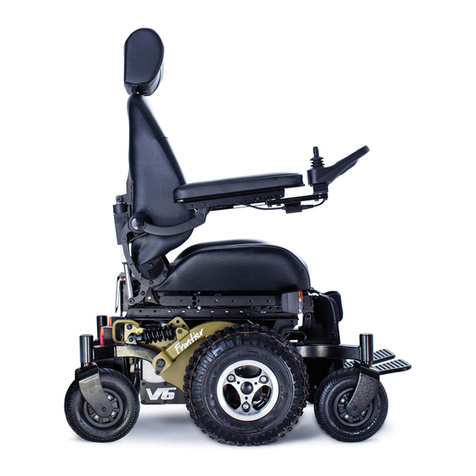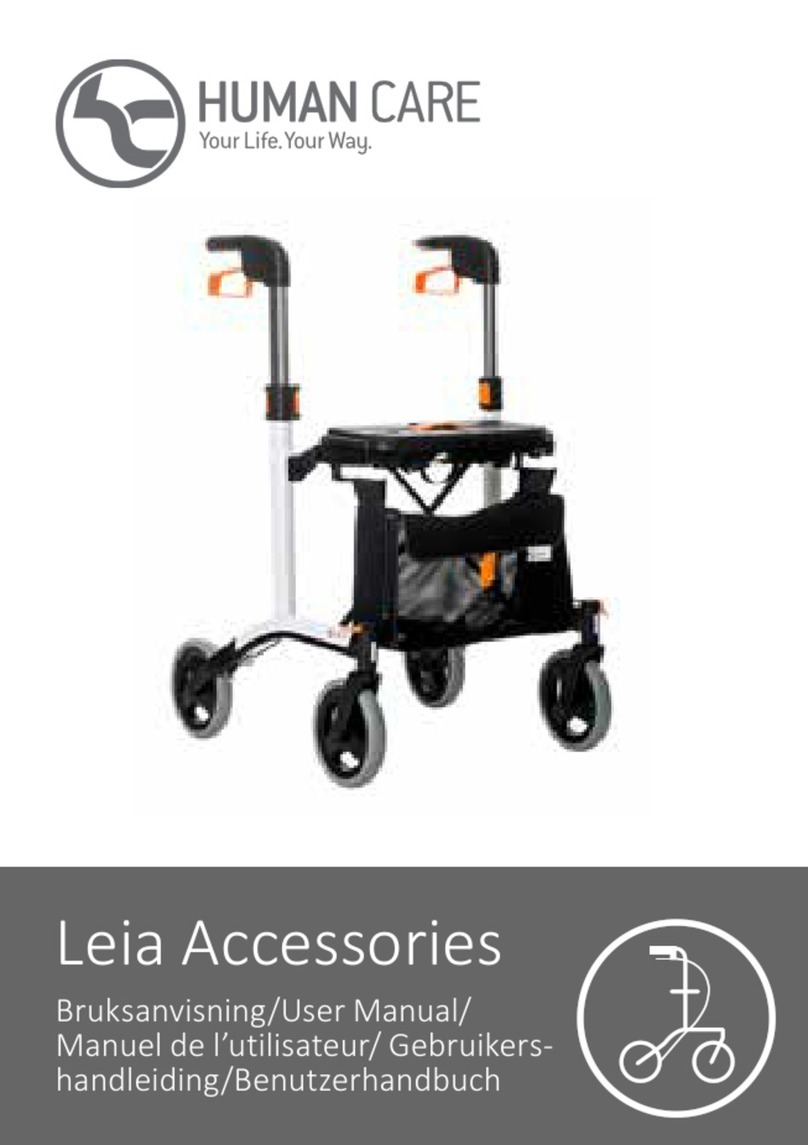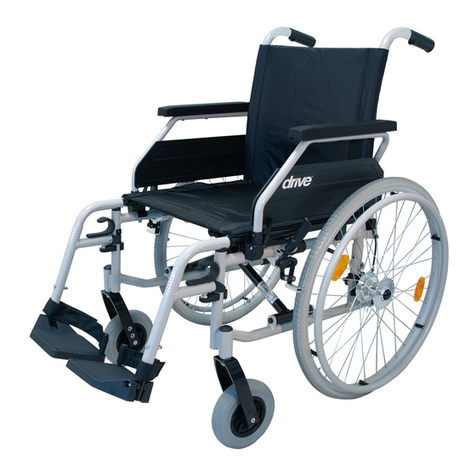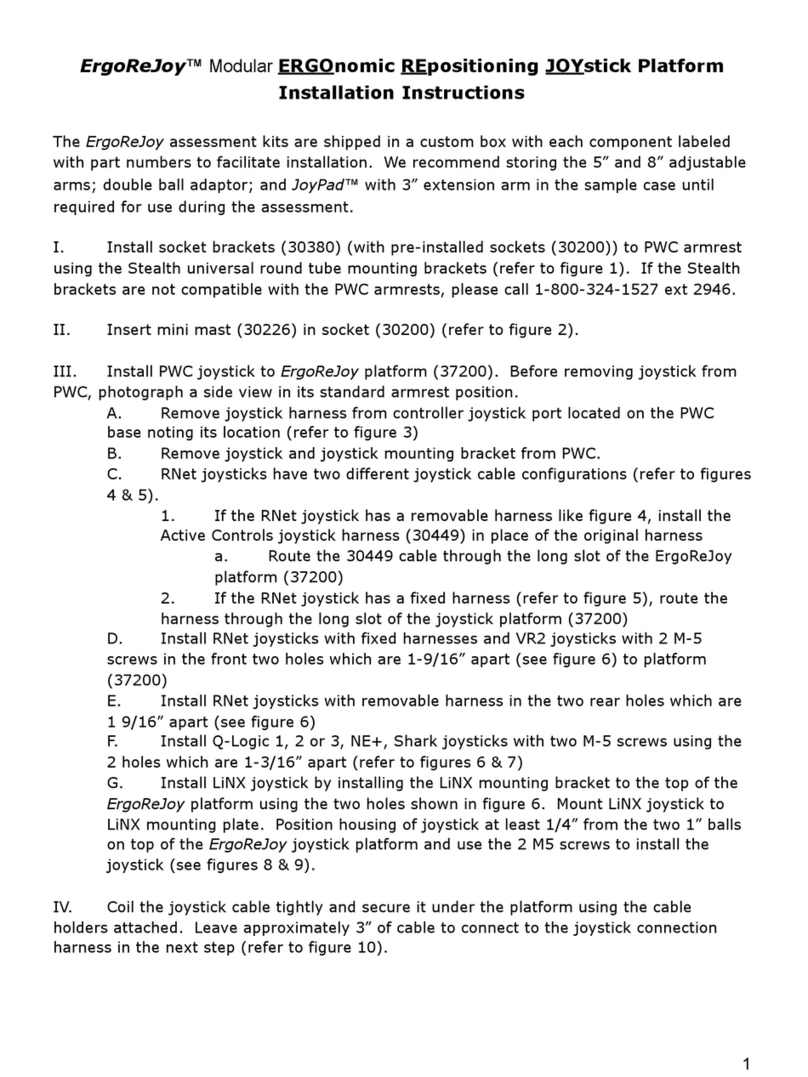Frontier V6 User manual

Page 1
Owners Manual
V6 Mid Wheel Drive all models
With Dynamic G90 controller

Page 2
www.magicmobility.com.au
YouTube: MAGIC MOBILITY OZ

Page 3
Contents
1Power Wheelchair Owner’s Manual ................................................................................ 5
1.1 Intended Use............................................................................................................ 5
2Safety and Damage Warnings ........................................................................................ 6
3Safety ............................................................................................................................. 6
3.1 Transfers.................................................................................................................. 6
3.2 Motor Vehicle Transport ........................................................................................... 7
3.3 Weight Limitations.................................................................................................... 7
3.4 Stairs and Escalators................................................................................................ 7
3.5 Transportation Products for your wheelchair............................................................. 7
3.6 Public Streets and Roadways................................................................................... 8
3.7 Stationary Obstacles: (Steps, Kerbs, Etc.)................................................................ 8
3.8 Climbing or Descending an Incline ........................................................................... 8
3.8.1 Maximum Recommended Incline....................................................................... 9
3.9 Removable Parts.....................................................................................................10
3.10 Cornering Information...........................................................................................10
3.11 Electromagnetic Fields (further information is in Appendix B –Electromagnetic
Interference (EMI).............................................................................................................10
3.12 Positioning Belts...................................................................................................11
3.13 Weather Precautions............................................................................................11
3.14 Reaching and Bending.........................................................................................11
3.15 Prescription Drugs/Physical Limitations................................................................11
3.16 Alcohol/Smoking ..................................................................................................11
4Specifications.................................................................................................................12
4.1 The Frontier.............................................................................................................12
4.2 Standards testing.....................................................................................................12
5Operating Instructions....................................................................................................13
5.1 Performance adjustments........................................................................................13
5.2 Positioning...............................................................................................................13
5.3 Freewheel Mode –pushing the power chair ............................................................13
5.4 Electrical Safety Protection......................................................................................14
5.5 Seat Tilt Option –if fitted .........................................................................................14
5.6 Power elevating seat option –if fitted ......................................................................14
5.7 ANSI/RESNA WC/Vol 1 –Section 19 and ISO7176-19 restraint system; if fitted.....15
6Joystick controls.............................................................................................................16
6.1 Joystick power.........................................................................................................16
6.2 Rain and Water .......................................................................................................16
6.3 Joystick lead............................................................................................................16
6.4 Controller program...................................................................................................16
6.5 Hand control joystick operation –figure 3 –G90A...................................................17
6.5.1 On/Off Button....................................................................................................17
6.5.2 Right Indicator (If Lights Are Fitted)..................................................................17
6.5.3 Horn..................................................................................................................17
6.5.4 Left Indicator (If Lights Are Fitted)....................................................................18
6.5.5 Mode.................................................................................................................18
6.5.6 ASK (Accessory Shortcut Key)..........................................................................18
6.5.7 Lighting Menu Mode –If Fitted (Not Standard)..................................................19
6.5.8 Lock Mode –If Fitted (Not Standard).................................................................19
6.5.9 The Joystick......................................................................................................19
6.5.10 Charging........................................................................................................20
7Batteries & Charging......................................................................................................20
7.1 Batteries..................................................................................................................20
7.2 Battery Charging......................................................................................................20
7.3 Charging Procedure ................................................................................................20
7.4 Public Transportation...............................................................................................21
7.5 Battery Disposal and Recycling...............................................................................21

Page 4
8Care & Maintenance......................................................................................................21
8.1 General Guidelines..................................................................................................22
8.2 Batteries..................................................................................................................22
8.3 Tyres and Castors...................................................................................................22
8.3.1 Tyre Inflation.....................................................................................................22
8.3.2 Tyre Wear.........................................................................................................23
8.4 Upholstery...............................................................................................................24
8.5 Cleaning..................................................................................................................24
8.6 Corrosion Protection................................................................................................24
8.6.1 Paint scratches and chips .................................................................................24
8.6.2 Beach, salt water and Coastal Areas.................................................................25
8.6.3 Snow and Ice, Salted Roads and Footpaths......................................................25
8.6.4 Post-usage Cleaning.........................................................................................25
8.6.5 Preventative Maintenance.................................................................................25
8.7 Storage....................................................................................................................25
8.8 Transportation.........................................................................................................26
8.9 Daily Checks ...........................................................................................................26
8.10 Weekly Checks ....................................................................................................26
8.11 Annual Checks.....................................................................................................26
9Servicing........................................................................................................................26
10 Fault finding................................................................................................................27
10.1 Limp Mode ...........................................................................................................27
10.2 Stuck Power Button..............................................................................................27
10.3 Joystick out of neutral at power up .......................................................................27
10.4 Battery Warning Conditions..................................................................................27
10.5 Fault Codes............................................................ Error! Bookmark not defined.
10.6 Electromagnetic Interference (EMI) From Radio Wave Sources...........................28
11 Technical Specifications .............................................................................................28
12 Warranty.....................................................................................................................29
12.1 Warranty policy ....................................................................................................29
12.2 Non OEM parts, assembly by a 3rd party and customisation.................................29
13 Head Office and Operations .......................................................................................30
Appendix A - ANSI/RESNA WC/Vol 1 –Section 19 & ISO7176-19 restraint system; if fitted 31
Appendix B –Electromagnetic Interference (EMI)................................................................39

Page 5
1 Power Wheelchair Owner’s Manual
Thank you for choosing a Magic Mobility Product. We are proud of the quality construction of
every chair we build. This owner’s manual explains the operation of your new chair. Please
read it carefully as it contains important safety, care and maintenance information.
Magic Mobility’s Power Wheelchair series may be custom made to measure and may vary in
detail from chair to chair however this owners manual should cover all basic features and
options. If your wheelchair has been customised especially for you, you can request
additional instructions.
Magic Mobility endeavours to supply a wide variety of features and options to meet the
needs of the user. However, final selection and specifications of the type of wheelchair to be
used by any individual rests solely with the user and his/her healthcare professional capable
of making such a selection. Magic Mobility can only stand by our performance specifications
when genuine Magic Mobility components have been used. When third party parts or
assembly has taken place, we strongly advise you seek additional instructions for use.
All of the information and specifications in this document are current at the time of printing.
However due to our policy of continual product improvements we reserve the right to make
changes at any time without notice. This may lead to slight variations between the
illustrations and explanations in this manual and the model you have purchased.
1.1 Intended Use
The intended use of a Magic Mobility Power Wheelchair is to provide mobility to persons with
a maximum weight of 182kgs (see section 3.3) limited to a sitting position that have the
capability of operating a powered wheelchair.
If you experience any problems with your power chair that you are unable to solve, or if you
do not feel capable of safely following any of the instructions and/or recommendations as
contained in this manual, please contact your Magic Mobility dealer. You will find the model
designation and serial number of the wheelchair on the base of the frame as shown below:
Magic Mobility is not liable for damage to property or personal injury arising out of unsafe use
of a power chair. Magic Mobility is also not liable for any property damage or personal injury
arising out of the failure of any person and/or user to following the instructions and
recommendations set forth in this manual.

Page 6
2 Safety and Damage Warnings
Throughout this manual, you will find the following safety and damage warnings.
WARNING! This is a warning which, if ignored, may cause injury to yourself
and other people
STOP! This is an instruction that, if not followed, may result in damage to your
Power chair. It means ‘do not do this’ or ‘do not let this happen’.
3 Safety
Please read and follow all instructions in this owner’s manual before attempting to operate
your power chair for the first time. If there is anything in this manual you do not understand,
or if you require additional assistance for setup, contact your Magic Mobility Dealer before
operating the wheelchair.
Buying the Frontier V6 opens up a whole new World and we are keen for you to explore new
possibilities. However, we strongly recommend that when learning your driving capabilities,
the capabilities of your wheelchairs and learning where potential hazards may be; you
always have someone with you as an All-terrain buddy. They can help check out the terrain
and also help you if you need it. We always recommend carrying a mobile phone or GPS
alert so that you can reach help if you need it.
There are certain situations, including some medical conditions, where the power chair user
will need to practice operating the power chair in the presence of a trained attendant. A
trained attendant can be defined as a family member or care professional specially trained in
assisting a power chair user in various daily living activities.
The contents of this manual are based on the expectation that a qualified healthcare
professional has properly fitted the power chair to the user and the prescribing healthcare
professional has trained the user in the operation of the wheelchair, the dangers that can be
encountered, and has ensured that the user is capable of this.
Using your Magic Mobility product safely also depends upon your own good judgement
and/or common sense, as well as that of your provider, caregiver, and/or health professional.
Magic Mobility is not responsible for injuries and/or damage resulting from any person’s
failure to follow the warnings, cautions and instructions in this owner’s manual.
WARNING! If you are going to be stationary in your power chair for an
extended period of time, turn off the power. This will conserve battery power
and remove the chance of unexpected chair movement through inadvertent
joystick contact or from electromagnetic sources
3.1 Transfers
It is recommended that you have a trained attendant present while you learn to transfer. To
reduce the chance of injury:
Be sure the power is turned off (See section Error! Reference source not found. Error!
Reference source not found.)
Be sure the power chair is not in freewheel mode (See section 5.3 Error! Reference
source not found.)

Page 7
Ensure footrests are swung away or removed
For side transfers ensure armrests and legrests are swung away or removed, position
yourself as far back as possible in the power chair seat to prevent the power chair from
tipping forward.
WARNING! Avoid putting all your weight on either armrests or footrests. This
may cause the power chair to tip and cause injury
3.2 Motor Vehicle Transport
Wheelchair positioning belts are not designed with the intent of providing proper restraint
during motor vehicle transportation. A WC19 and ISO7176-19 compliant system is available
from Magic Mobility. More information is contained in section 5.7.
WARNING! Wheelchair users should be transferred into appropriate seating in
vehicles for transportation and use made of the restraints made available by
the auto industry.
3.3 Weight Limitations
Your power chair is rated for a maximum weight capacity of 182 kg (see table). Do not carry
passengers or heavy weights on any part of the wheelchair.
SEATING ARRANGEMENT
MAXIMUM USER WEIGHT
No seat elevator fitted
182 kg
Seat elevator or tilt fitted
155 kg
STOP! Exceeding the weight capacity voids your warranty and may result in
damage to your power chair.
3.4 Stairs and Escalators
This power chair is not specifically designed to negotiate stairs but is able to do so only in
cases with low step heights and long step landings.
WARNING! Take great care using your power chair to negotiate stairs. Never
use your power chair to negotiate escalators. Always use an elevator or lift
where possible. You may cause injury to yourself and to others.
STOP! Trying to negotiate stairs or escalators may result in damage to your
power chair.
3.5 Transportation Products for your wheelchair
If it is necessary to use a transportation product such as a vehicle hoist or lift, Magic Mobility
recommends that the manufacturer’s instructions and specifications are closely reviewed
before using that product.

Page 8
3.6 Public Streets and Roadways
WARNING! You should not operate your power chair on public streets and
roadways. This is in accordance with local traffic laws, which vary by country.
Please check your local traffic laws. Be aware that it may be difficult for traffic
to see you when you are seated on your power chair. Obey all local pedestrian
traffic rules. Wait until your path is clear of traffic, and then proceed with
extreme caution
3.7 Stationary Obstacles: (Steps, Kerbs, Etc.)
Proceed with extreme caution when driving near raised surfaces, unprotected ledges, and/or
drop-offs (kerbs, porches, stairs, escalators, lifts etc). Always approach an obstacle so both
front wheels touch that obstacle together. Never attempt to climb a kerb or obstacle at an
angle. See Figure 1 for details.
Figure 1 - Correct and Incorrect Approaches to Obstacles
WARNING! Do not attempt to have your power chair climb or descend an
obstacle that is higher than 50mm unless you have the assistance of an
attendant. The power chair can be capable of climbing an obstacle of up to
100mm in height however this can be much lower depending on the setup of
the wheelchair. Never try to travel backwards down any step, kerb, or other
obstacle. This may cause the power chair to tip and cause personal injury.
STOP! Do not attempt to climb obstacles when the seat is reclined or elevated.
3.8 Climbing or Descending an Incline

Page 9
When climbing an incline, try to keep your power chair moving; however do not use
excessive speed. If you must stop, start up again slowly and then accelerate cautiously. if at
anytime you feel uncomfortable, reduce your acceleration rate.
When driving down an incline, set your power chair to the slowest speed setting and drive in
the forward direction only. If your power chair starts to move down the incline faster than you
anticipated or desired, allow it to come to a complete stop by releasing the joystick. Once the
chair has stopped push the joystick forward slightly to ensure a safely controlled descent.
The following advice is recommended for your safety:
Do not drive at an angle up or down the face of the incline. Drive your power chair
straight up or down the incline. This greatly reduces the possibility of tipping the chair
over.
Avoid potentially hazardous inclines e.g. areas covered with snow, ice, mud, cut grass, or
wet leaves.
As with all four wheel driving adventures, you should always be sure that the terrain
ahead of you is clear of unexpected hazards. We advise that you have someone with you
who can check ahead for any hazards.
When exploring alone, proceed with extreme caution and we advise you always carry
your mobile phone or GPS alert so that you can reach help.
Avoid sudden stops and starts
When on any sort of an incline or decline, never place the power chair in freewheel mode
while seated on it or standing next to it.
Never attempt to travel backwards down an incline.
WARNING! Always exercise extreme caution on inclines and follow the advice
above to reduce the risk of personal injury
3.8.1 Maximum Recommended Incline
Most public access ramps have a maximum gradient 1 in 14 (AS1428.1). Therefore, Magic
Mobility recommends that the maximum slope of an incline you attempt to safely ascend or
descend on your power chair does not exceed a 1 in 14 gradient.
Given the off-road capabilities of the power chair, inclines of up to 30° can potentially be
ascended depending on the setup of the wheelchair, weight distribution, and terrain
conditions. Extreme care must be taken when ascending any incline over a 1 in 14 gradient
to ensure the wheelchair is not driven in an unstable position.
WARNING! Any attempt to climb or descend a slope steeper than 1 in 14
gradient may put your power chair in an unstable position and cause it to tip,
resulting in personal injury.

Page 10
Figure 2 –1 in 14 Gradient
3.9 Removable Parts
STOP! Do not attempt to lift or move a power chair by any of its removable
parts (armrests, legrest, backrest). This may result in personal injury and/or
damage to the chair.
3.10 Cornering Information
Excessively high cornering speeds can create the possibility of tipping. If you feel that you
may tip over in a corner, immediately reduce your speed and steering angle (i.e. lessen the
sharpness of the turn)
The following advice is recommended for your safety:
Reduce cornering speed
Reduce steering angle
Beware of uneven, rough and slippery terrain
Avoid turning on inclined surfaces
Be aware of changing surfaces - such as passing from a paved area to a gravel area at
high speed while turning
Avoid abrupt directional changes.
WARNING! When cornering, lower your speed and follow the advice above to
reduce the risk of personal injury
3.11 Electromagnetic Fields (further information is in

Page 11
Appendix B –Electromagnetic Interference (EMI)
Your power chair’s performance may be influenced by electromagnetic fields caused by
mobile telephones or other radiating devices, such as hand-held radios, radio and television
stations, wireless computer links, microwave sources, and pagers.
Your power chair may also be a source of electromagnetic and radio frequency interference.
Be aware that your power chair may affect the performance of alarm systems and other
radiating devices.
WARNING! Turn off your power chair when using products, which emit
electromagnetic fields. This will eliminate the possibility of unintended
movement caused by electromagnetic sources. Failure to take this precaution
may result in personal injury
3.12 Positioning Belts
Do not sit on your power chair while it is in a moving vehicle refer to section 3.2 Motor
Vehicle Transport.
It is the obligation of the purchasers, therapists and other healthcare professionals to
determine if a positioning belt is required to ensure the safe operation of this equipment by
the user.
WARNING! Ensure your positioning belt is fastened securely. Serious personal
injury may result if you fall from the power chair.
3.13 Weather Precautions
WARNING! Do not operate your power chair in icy or slippery conditions or on
salted surfaces (i.e.; footpaths and roads). Such use may adversely affect the
performance and safety of your power chair, resulting in an accident and
personal injury.
3.14 Reaching and Bending
WARNING! Avoid bending, leaning, or reaching for objects while seated in the
wheelchair. If you have to pick them up from the floor we suggest you use a
specially designed “Pick up stick”. Movements such as these may cause your
power chair to tip, possibly resulting in personal injury.
3.15 Prescription Drugs/Physical Limitations
Consult your physician if you are taking prescribed or over-the-counter medication or if you
have certain physical limitations.
WARNING! Some medications and limitations may impair your ability to
operate your power chair in a safe manner, possibly resulting in personal injury
to yourself and others.
3.16 Alcohol/Smoking
WARNING! Do not operate your power chair while you are under the influence
of alcohol, as this may impair your ability to operate your power chair in a safe
manner, resulting in personal injury to yourself and others.

Page 12
WARNING! It is strongly recommended that you do not smoke cigarettes while
seated in your wheelchair. The power chair has passed the necessary
flammability requirements, but it is strongly advised to keep ashtrays at a safe
distance from seat cushions, to ensure cigarettes are completely extinguished
before disposal, and we strongly advise against leaving lit cigarettes
unattended.

Page 13
4 Specifications
4.1 The Frontier
A Frontier power chair is depicted below. This Figure 3 will help you identify some of the
features referred to throughout this manual.
Figure 3 - Basic V6 specifications
4.2 Standards testing
Information regarding the performance attributes and controlled testing results of the power
chair may be obtained from the power chair manufacturer. If you would like access to this
information, please contact your Magic Mobility Dealer.
Backrest
Armrest
Joystick
Seat
Footrest
Front
Castors
Drive
Wheels
Power
Base
Rear
Castors
Seat
Elevator
Seat Tilt
Headrest

Page 14
5 Operating Instructions
The speed and direction of the power chair is controlled with by the joystick
Turn on your power chair (see section Error! Reference source not found.)
Use the joystick to control the speed and direction of travel
At times, particularly during high acceleration on inclines, not all of the 4 castor wheels will
contact the ground. This is a normal part of the chairs operation; if at anytime you feel
uncomfortable, reduce your acceleration rate or speed.
5.1 Performance adjustments
Performance adjustments to your power chair should only be made by professionals of the
healthcare field, or by persons fully conversant with both this process and the driver’s
capabilities.
WARNING! Changing the performance settings could adversely affect your
power chair. You may cause injury to yourself and to others.
STOP! Incorrect settings could cause damage to the chair and to surrounding
property.
5.2 Positioning
If your power chair was configured at your Magic Mobility Dealer, please consult your health
care professional before changing the seat position or making any other adjustment. Some
adjustments may degrade your power chair’s performance and safety by changing its centre
of gravity.
5.3 Freewheel Mode –pushing the power chair
Located on each side of the chair, in front of each drive wheel is a motor release lever (see
Figure 4). To disengage the built-in or “running” brakes simply push the down levers on each
side.
Figure 4 - Motors engaged / disengaged
The wheelchair controls will not function and the “status” light on the joystick will flash when
the chair is in free-wheel mode. This feature has been intentionally incorporated to protect
the user from unsafe situations. These levers are intended for use by the attendant.

Page 15
Don’t forget to push the levers back in again firmly after manually positioning the chair
WARNING! Do not use your chair in freewheel mode or attempt to place your
chair into freewheel mode without an attendant present. You may cause
injury to yourself and to others. Do not place your power chair in freewheel
mode while on an incline. The chair could roll uncontrollably on its own,
leading to injury to yourself and others.
WARNING! When the power wheelchair is in freewheel mode, the braking
system is disengaged.
5.4 Electrical Safety Protection
Your wheelchair has a fuse fitted into the battery circuit to protect the motors and electronics
from an accidental current overload. In the case of a blown fuse, the chair will not drive and
you will need to contact your Magic Mobility dealer for repair / replacement
5.5 Seat Tilt Option –if fitted
To operate the seat tilt:
Bring your power chair to a complete stop on a flat level surface.
Always fasten the positioning belt when operating the seat tilt option.
Push the ‘Accessory Mode Selection’ button on the DX2 joystick. Select
seat tilt by moving the joystick left or right. Once the seat tilt option is
highlighted (as shown to the right), moving the joystick forward or
backwards will operate the function.
Once the seat reaches its highest tilt angle, the tilt action stops; release the joystick at
this point.
Before driving, return the seat to its upright position. When returning to the upright
position, always be sure that the mechanism has reached its lowest limit or normal
seated position.
WARNING! Never tilt the seat from its upright position on an inclined surface or
on bumpy or uneven surfaces. Never raise the seat tilt while your power chair
is in freewheel mode. Failure to heed this warning can result in the power chair
tipping over and causing personal injury.
CRITICAL! Do not put your fingers, toes or any objects into the tilt mechanism
while it is operating. Serious personal injury will occur.
5.6 Power elevating seat option –if fitted
The power elevating seat will allow more freedom and independence by
extending your level of reach. The seat height can be adjusted to match a
surface to which you are transferring.
The scissor action of the seat elevator may be a dangerous hazard. Under no circumstances
should you put your hands, fingers, toes or any part of your body in the seat elevator
mechanism while it is operating. Ensure that no one in the vicinity of the wheelchair has any
part of their body in the seat elevator mechanism while it is working.
To operate the power elevating seat:
Bring your power chair to a complete stop on a flat level surface.
Always fasten the positioning belt when operating the power elevating seat.

Page 16
Push the ‘Accessory Mode Selection’ button on the DX2. Select power elevating seat by
moving the joystick left or right. Once the power elevating seat option is highlighted (as
shown to the right), moving the joystick forward or backwards will operate the function.
Once the seat reaches its highest elevation, the action stops; release the joystick at this
point.
Before driving, always be sure that the mechanism has returned the seat to its lowest
position.
The power seat elevator is fitted with a system that reduces the speed of the power
wheelchair when the seat has been elevated approximately 50mm.
WARNING! Fasten the positioning belt when using the seat elevator
WARNING! Never elevate the seat from its lowest position on an inclined
surface
WARNING! Never raise the seat when crossing bumpy or uneven surfaces
WARNING! Do not put the power wheelchair into freewheel mode with the seat
elevated
WARNING! Maintain recommended tyre pressures for good stability
STOP! Do not put your fingers, toes or any other body part or object into the
scissor mechanism while it is operating. Serious personal injury will occur.
5.7 ANSI/RESNA WC/Vol 1 –Section 19 and ISO7176-19 restraint system; if fitted.
This wheelchair conforms with the requirements of ANRI/RESNA WC/19 and ISO7176-19.
Magic Mobility recommends that wheelchair users are NOT transported in vehicles of any
kind while in wheelchairs. The Department of Transportation has not approved any tie-down
system for transportation of a user while in a wheelchair in a moving vehicle of any type. It is
Magic Mobility’s position that users of wheelchairs should be transferred into appropriate
seating in vehicles for transportation and use be made of the restraints made available by the
auto industry.
For detailed information see Appendix A - ANSI/RESNA WC/Vol 1 –Section 19 &
ISO7176-19 restraint system; if fitted
NOTE:
ANSI = American National Standards Institute
RESNA = Rehabilitation Engineering and Assistive Technology Society of North America
ISO = International Organisation for Standardisation

Page 17
6 Joystick controls
A detailed manual for the DX2 joystick is available from Dynamic Control’s website:
www.dynamiccontrols.com.
The joystick controls may be customised and may be one of a number of different models
depending upon users requirements. This manual contains detailed information on the
standard joystick control.
6.1 Joystick power
If the power chair begins to move in an unexpected manner, immediately release the joystick
and turn the wheelchair off. Unless the joystick is damaged, this should stop your power
chair.
If the joystick is not in the neutral (centre) position when you turn on the power, you may
cause a fault in the system. Releasing the joystick and turning the power off and on again will
reset the system.
WARNING! Always turn the power off when you are stationary to
prevent unexpected movement.
6.2 Rain and Water
The joystick hand control unit IS NOT WATERPROOF. The joystick module is splash proof
but may be permanently damaged if water transgresses the rubber seals (this damage is not
covered under warranty).
We recommend carrying a plastic bag large enough to cover the joystick module and
the user’s hand, in case of rain.
6.3 Joystick lead
If for any reason, the joystick lead is disconnected take care when reconnecting, do not force
the plug into the socket. The lead is polarised and should only be fitted one way.
STOP! Forcing the plug into the socket the wrong way can
permanently damage the electronics system. Also, do not place the
lead so that it can be pinched in the seat frame or the power base
frame.
6.4 Controller program
The controller program affects speed, acceleration, deceleration, and braking. The drive
mode settings are preset at the factory. If your Magic Mobility Dealer/ healthcare professional
changes these settings, please make note of these changes.
WARNING! Do not attempt to reprogram your chair. Only the power
chair manufacturer, an authorised representative of the manufacturer,
or a trained service technician should program the controller.

Page 18
6.5 Hand control joystick operation –figure 3 –G90A
Hand Controller DXREMG90A
6.5.1 On/Off Button
To turn the power on press the On/Off button.
The current battery charge will be indicated and the System
Status LED will illuminate and not flash.
Press the On/Off button again to turn the power off.
6.5.2 Right Indicator (If Lights Are Fitted)
To turn the Right Indicator on/off, press and release (‘short
press’) the Right Indicator button.
To toggle the Hazard Lights on/off, press and hold (‘long
press’) the Right Indicator button.
6.5.3 Horn
Pressing the Horn button will sound the horn for as long as
the button is pressed.

Page 19
6.5.4 Left Indicator (If Lights Are Fitted)
To turn the Left Indicator on/off, press and release (‘short
press’) the Left Indicator button.
To toggle the Headlights on/off, press and hold (‘long press’)
the Right Indicator button.
6.5.5 Mode
Each press of the Mode button will increment the drive profile,
up to the maximum configured value and then back to profile
The current drive profile will be shown in the 7 Segment
Display.
Note:
If the chair is driving and the Mode button is pressed, the drive profile
will increase by a single increment with each press until the maximum
configured value is reached.
The Mode button does not enter the accessory modes.
6.5.6 ASK (Accessory Shortcut Key)
If you are in Drive Mode, a press of the ASK button will
navigate you to the last used accessory function, e.g. actuator
control. If you are already in Accessory Mode, a press of
ASK will take you to the next available accessory mode, e.g.
ECU or lighting. To return to Driving, simply press the Mode
button.
This feature significantly reduces the complexity and number
of key presses to access common features.
Note:
If the chair is driving and the ASK button is pressed, the command is
ignored until the chair has stopped.

Page 20
6.5.7 Lighting Menu Mode –If Fitted (Not Standard)
When in Lighting Menu Mode, the 7 Segment display
shows 3 horizontal lines.
Moving the joystick forward will toggle the Headlights.
Moving the joystick left will toggle the Left turn
Indicators.
Moving the joystick right will toggle the right turn
Indicators.
Moving the joystick backward will toggle the Hazard
Lights.
6.5.8 Lock Mode –If Fitted (Not Standard)
The Key Lock system uses a magnetic key to power the
wheelchair down to prevent subsequent unauthorized driving.
To Lock the system:
Swipe the magnetic key across the key symbol on the G90A
Remote. The system will beep and automatically power itself
down.
To Unlock the system:
Press the On/Off button to power up the system. The flashing
red key symbol shows the system is locked. Swipe the
magnetic key across the key symbol the LED will stop
flashing the chair may be driven as normal. If the wheelchair
is not unlocked, G90 will automatically turn itself off.
6.5.9 The Joystick
Moving the joystick will cause the power chair to drive in
that direction. The amount of joystick movement will
determine the speed that the power chair will move in that
direction.
Joystick Out of Neutral at Power up (OONAPU) occurs
if the joystick is out of neutral when switched on. If this
happens the System Status LED will flash constantly.
Releasing the joystick within a few seconds will cancel the
indication otherwise a ‘latching fault’ will occur.
Other manuals for V6
1
Table of contents
Other Frontier Wheelchair manuals
Popular Wheelchair manuals by other brands

Invacare
Invacare Action 4NG series user manual

Sunrise Medical
Sunrise Medical Guardian Escort User instruction manual & warranty
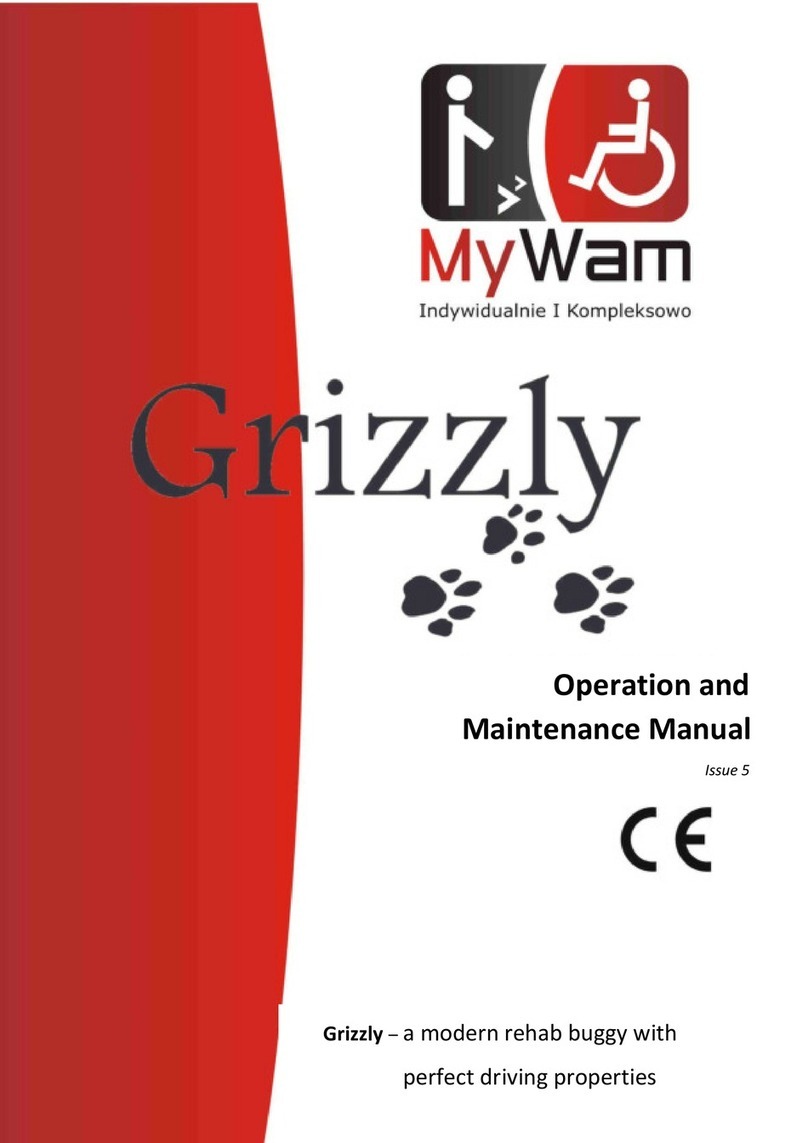
MyWam
MyWam Grizzly Operation and maintenance manual

Pegasus Zorg
Pegasus Zorg VARIA user manual
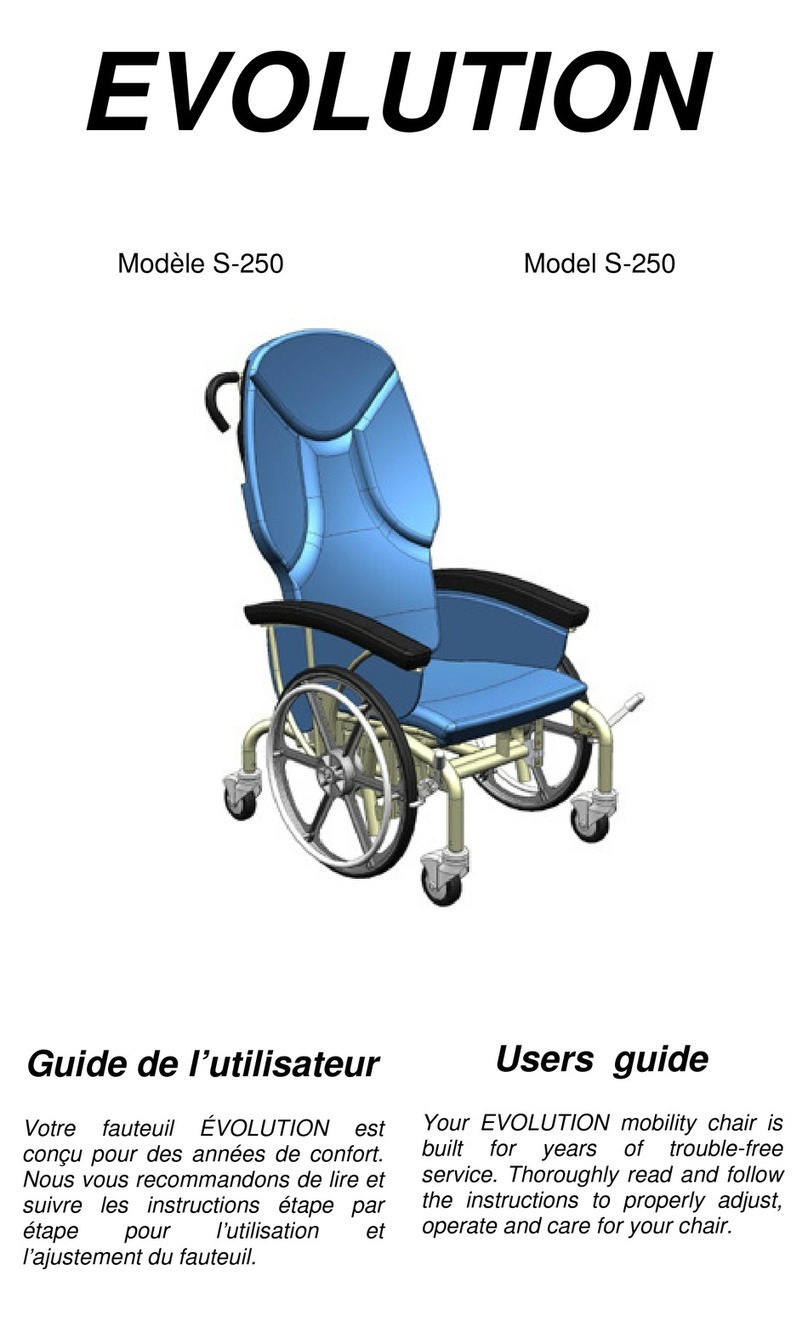
Evolution
Evolution S-250 user guide
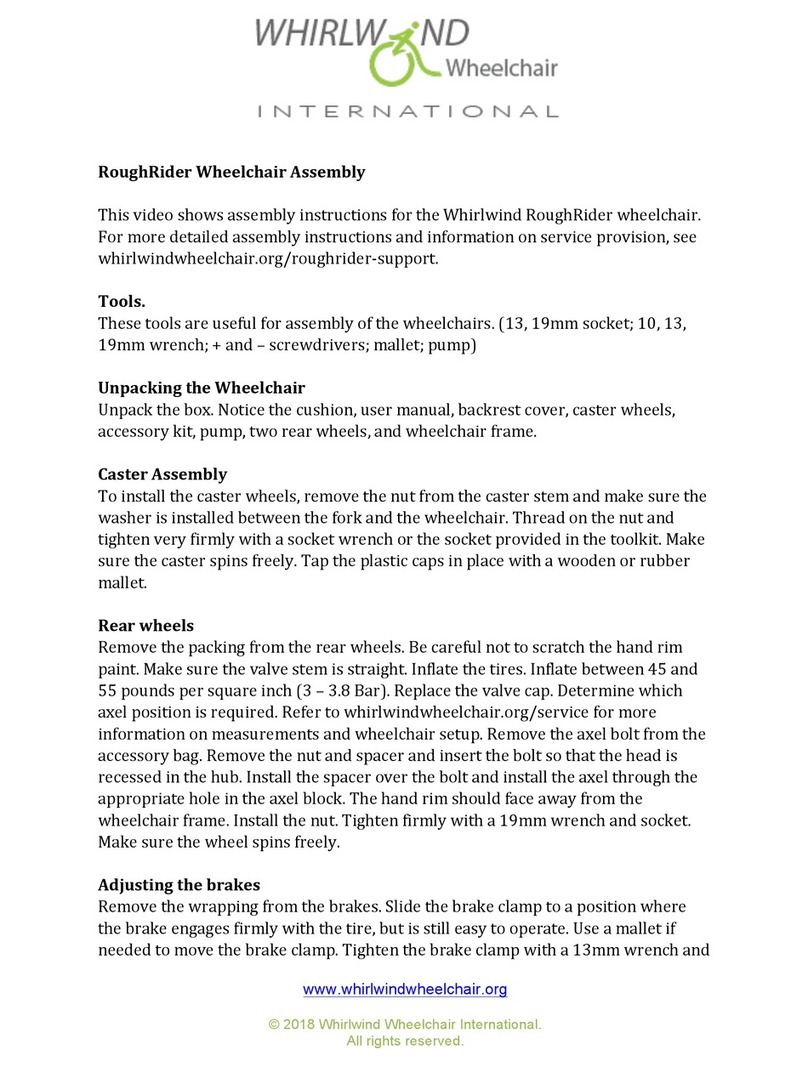
Whirlwind
Whirlwind RoughRider Assembly manual
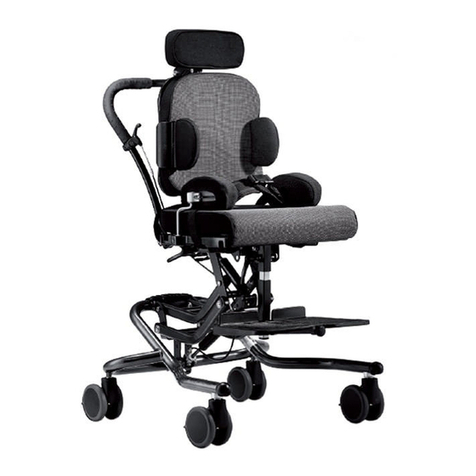
R82
R82 wombat basic Mounting instruction

Gima
Gima 27708 Use and maintenance book
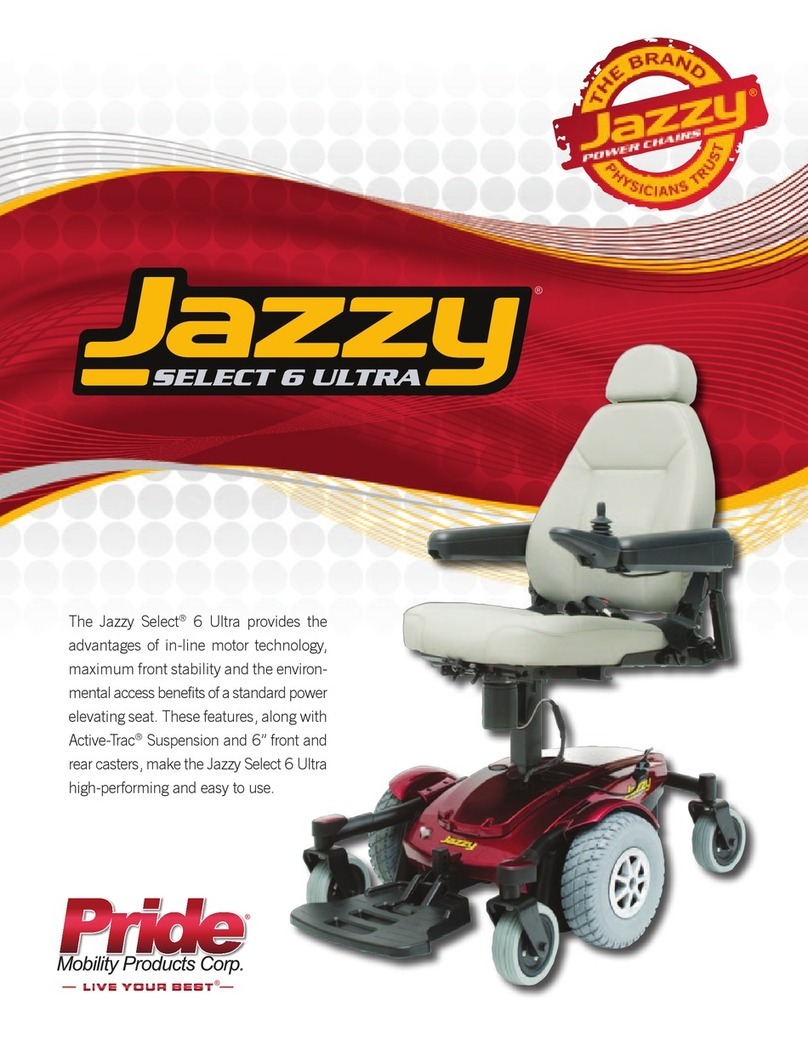
Pride Mobility
Pride Mobility Jazzy Select 6 Ultra PG VR2 Specifications

Home Care Medical
Home Care Medical HCM9095 introduction
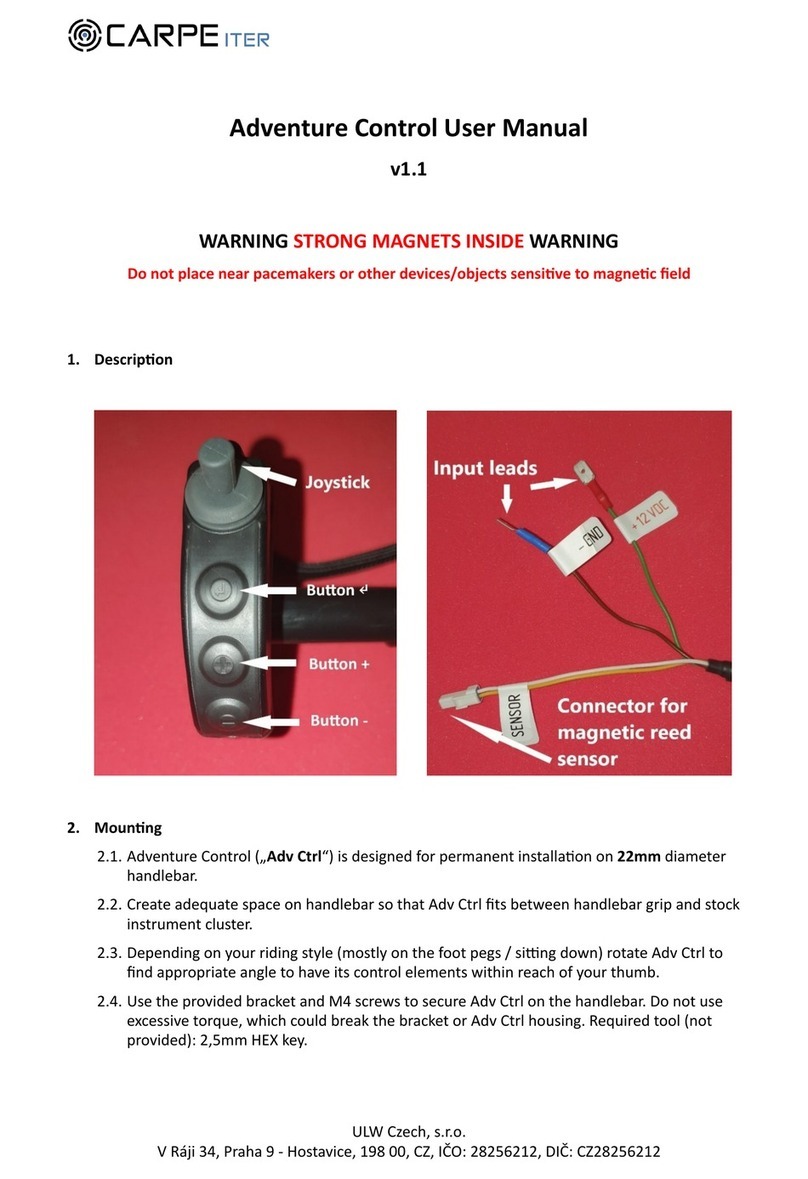
Carpe Iter
Carpe Iter Adventure Control user manual
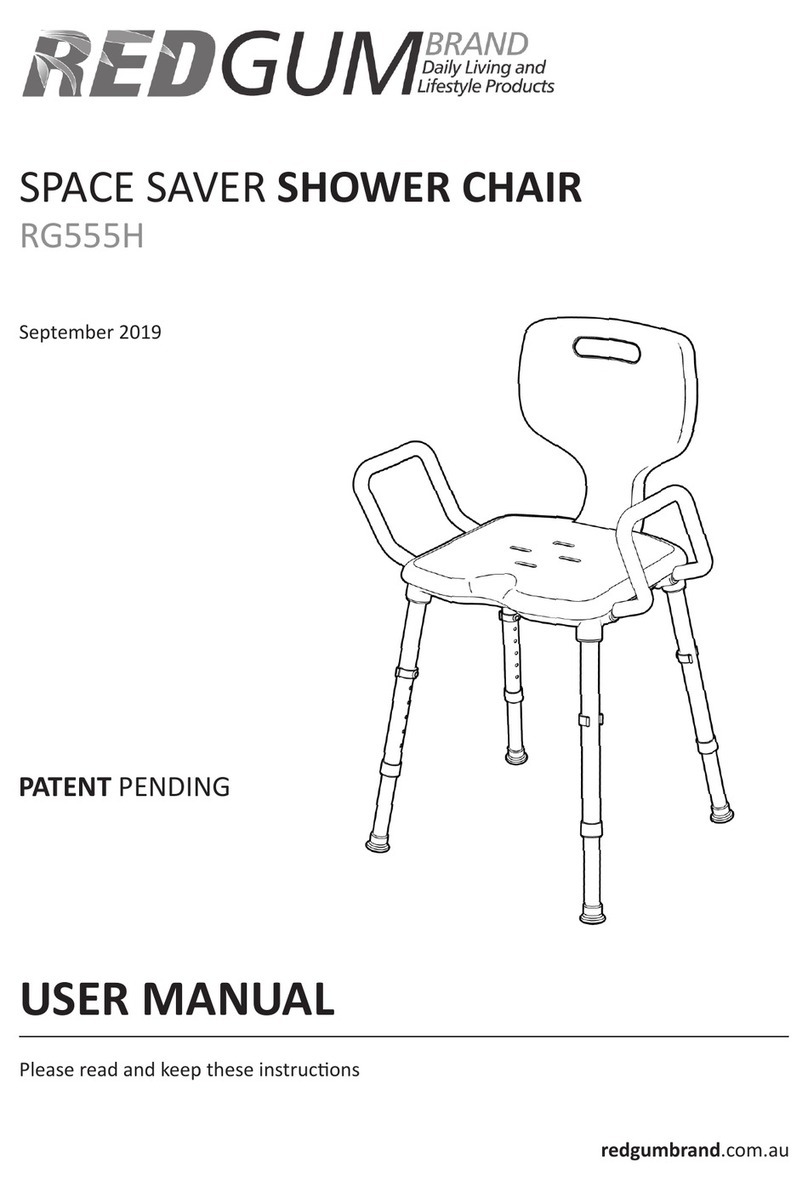
REDGUM Brand
REDGUM Brand SPACE SAVER RG555H user manual
